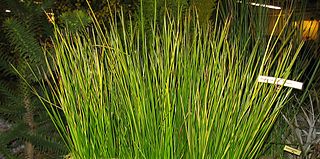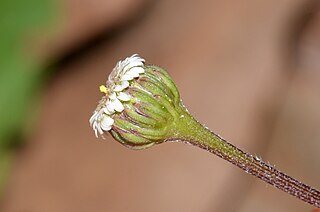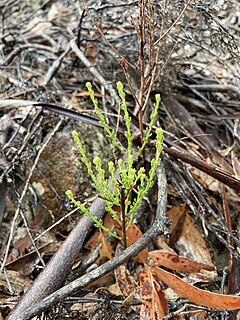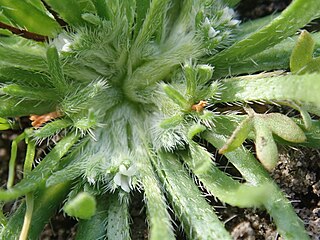
Olearia argophylla is a species of flowering plant in the family Asteraceae. Its common names are musk daisybush, musktree, muskwood and silvershrub. It is found in Australia, specifically in New South Wales, Tasmania and Victoria. It grows as a tall shrub or tree characteristic of wet sclerophyll forest. Its leaves are large and broad, coarsely toothed, green on top and silver-white underneath. The grain of the wood is mainly straight, but burls near the base of the tree are prized for their brown swirls that often suggest the appearance of small faces or animals peering out of the wood, making them highly sought after by woodworkers.

Aphanopetalum resinosum, known as the gum vine, is a small plant growing in rainforest or eucalyptus forest in eastern Australia, from north-east Victoria, through New South Wales and north to Queensland.

Baumea is a genus of the sedge family, which includes around 30 species native to Madagascar and the Pacific Islands, with 15 species in Australia. All are perennial rhizomatous herbs, with leaves and stems very similar in appearance. The inflorescence is terminal, with the flowers tightly clustered or loosely arranged. The fruits are small nuts.

Coprosma nitida, the mountain currant or shining currant, is a shrub species endemic to south-east Australia. It is a shrub with small, glossy leaves, occasional spines on the end of its branchlets, and small bright red-orange fruits.

Monotoca scoparia, commonly known as prickly broom heath, is a widespread native species across south-eastern Australia. Monotoca scoparia was formerly in the family Epacridaceae but now belongs to the family Ericaceae. Monotoca is an endemic Australian genus with 17 described species occurring in all states.
Hibbertia ericifolia is a species of small perennial shrub, in the family Dilleniaceae, that is endemic to eastern Australia. It has small yellow five-petalled flowers 3.2-7.8 mm long and 1.3-2.3 mm wide.

Tmesipteris obliqua, more commonly known as the Long fork-fern or Common fork-fern, is a weeping, epiphytic fern ally with narrow unbranched leafy stems. T. obliqua is one of many species apart of the genus, Tmesipteris, more commonly known as "hanging fork-ferns". Tmesipteris is one of two genera in the order Psilotales, the other genus being Psilotum. T. obliqua is endemic to eastern Australia.

Nymphoides crenata, commonly known as wavy marshwort, is an aquatic perennial herb of the family Menyanthaceae endemic to Australia, found in all mainland states and the Northern Territory

Baumea acuta, commonly known as pale twig-rush, is a flowering plant in the sedge family, Cyperaceae, that is native to southern parts of Australia.

Machaerina rubiginosa, commonly known as soft twig rush, flat leaf twig rush or common twig rush, is a flowering plant in the sedge family, Cyperaceae, that is native to Asia and the Pacific.

Hypericum japonicum, known as matted St. John's-wort, is an annual herbaceous flowering plant in the St. John's wort family Hypericaceae, in Hypericum sect. Trigynobrathys.

Lagenophora huegelii is a species of flowering plant in the daisy family (Asteraceae) which is endemic to Western Australia. It was formerly considered to also grow in eastern Australia and Tasmania, though these populations are considered a separate species: Lagenophora gunniana.

Gonocarpus teucrioides, or forest raspwort is a common flowering herb or subshrub in the Haloragaceae, or watermilfoil family. It is native to Queensland, New South Wales, Victoria and Tasmania and is widespread and abundant in the understorey of wet forests. The name raspwort refers to the rough, scabrous surface of many of the Gonocarpus species.

Rumex vesicarius, also known as Ruby dock, or bladder dock, is a species of perennial flowering plant in the family Polygonaceae. According to Plants of the World Online, Rumex vesicarius is native to tropical and temperate Asia, Africa, and Western Australia. However, the Council of Heads of Australasian Herbaria asserts that within Australia it is naturalised in Western Australia, the Northern Territory, South Australia, Queensland and New South Wales.
Conospermum patens, commonly known as the slender smokebush, is a plant of the family proteaceae native to Victoria.

Plagiobothrys plurisepaleus is a species of flowering plant in the borage family. It is native to Australia, being found in all mainland states: New South Wales, Queensland, Victoria, South Australia, Western Australia and the Northern Territory, in moist areas in and around claypans.

Codonocarpus cotinifolius a tall shrub or tree in the Gyrostemonaceae family is a found in all mainland states of Australia, including Victoria, and is widespread in arid areas. It is suspected of being toxic to stock.

Comesperma calymega, commonly known as blue-spike milkwort, is a slender herb in the family Polygalaceae. It is a perennial herb growing to between 10 cm and 50 cm high, from a short woody rhizome.

Westringia rigida is a shrub in the Lamiaceae family that is endemic to Australia, and found in Western Australia, South Australia, Victoria, New South Wales and Tasmania.

Coprosma moorei, commonly known as blue matcurrant or turquoise coprosma, is a small, mat forming, prostrate shrub in the Rubiaceae family. It is native to highland areas of Tasmania and Eastern Victoria.
















